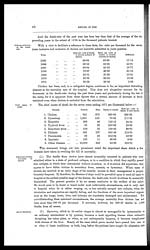Medicine - Institutions > Reports from medical colleges, schools and research institutions > Report on the Calcutta medical institutions > Calcutta medical institutions reports 1871-78 > Report on the Calcutta Medical Institutions for the year 1871
(59) Page 49
Download files
Individual page:
Thumbnail gallery: Grid view | List view

49
PRESIDENCY GENERAL HOSPITAL.
hospital. It is not surprising therefore that the ratio of deaths to treated has amounted to
76.82 per thousand, and that out of every thousand deaths from all causes, dysentery is
answerable for 111.31.
Hepatitis.
3. Hepatitis has long formed a subject of careful observation and discrimination at this
hospital. In the above statement the term comprises not only inflammation ending in resolu-
tion and ultimate reparation, but also those cases which have terminated in abscess. Here
again the opportunity of successfully combating inflammation of the liver and preventing its
termination in abscess has too often been lost long before the admission of these cases into
hospital. There can be no doubt but that by prompt and vigorous treatment such an
unfavorable result can often be averted. And, doubtless, the practice followed has had much
to say to the fact that the deaths to treated have only been 133.15 per thousand, and that it
has only accounted for 44.34 deaths per thousand deaths from all causes.
Dieulafoy's pneu-
matic aspirator.
It may not be out of place here to solicit attention to an ingenious contrivance in the
shape of Dr. Dieulafoy's (of Paris) Pneumatic Aspirator (improved by Weiss of London), by
means of which the largest abscesses of the liver can be emptied without more pain than is
experienced in the employment of drugs by the hypodermic method, and without the
admission of atmospheric air, whilst they can be washed out by carbolic acid or other anti-
septic solutions, also without the risk of admitting air. It may be used for the emptying
and washing out of abscesses in almost every part of the body; and so used, it will very
frequently save the patient from the knife and a certain amount of consequent disfigurement,
and, it may be, mutilation. Thus, abscesses in the neck may be drained of their contents and
thoroughly disinfected through an opening not larger than that which would be made by the
insertion of the nozzle of a hypodermic syringe. Iliac abscesses not implicating bone, might also
be cured in the same way, and the patient saved from large incisions through the abdominal
muscles or below Poupart's ligament. Long standing pleuritic effusions, empyema, and
effusion into the pericardium, might also be relieved without in the slightest degree risking
insuperable injury to the lungs or heart. Lately, I drew off 74 ounces of pus from a liver
abscess of a private patient with this instrument, kindly lent me by Dr. MacConnell. About
a week later a pint and a half was removed, and three days afterwards about a pint more, with a
hopeful result. When acting as Professor of Medicine in the Medical College, Dr. Buckle, C.B.,
then Principal Medical Store-Keeper, kindly had an exhausting syringe, provided with a
canula armed with stop cock, constructed under my supervision. With this an abscess can be
emptied completely and washed out with disinfectant fluids without risking the admission of
air; and I have since several times employed it with success. In August last, assisted by
Doctors Cutcliffe and Lyons, the patient having been put under the influence of chloroform
by Dr. Lyons, I drew of 84 ounces, more than half a gallon, from the liver abscess
of an American, a mechanical engineer in the service of Government, with my imperfect and
clumsy apparatus, and afterwards washed it out with carbolic acid solution until the last
portions came away almost clear and limpid as water. Three days afterwards the canala
was reinserted and a pint and a half of puriform matter was removed. Mr. Saunders, the
Deputy Inspector-General, kindly assisted me on this occasion. It was also well washed out
and disinfected. The patient a couple of days after this sailed in one of the P. and O. Com-
pany's steamers. He was troubled with fever as far as Galle, after which he gained a pound
per diem between that place and London. Three months afterwards he reported from
Philadelphia that his physician had repeatedly examined his liver and assured him that its
size was normal, and that but for the statement of his case, with which he had been furnished
by me on his departure, he could not have believed that the patient had been the subject of
such extensive disease.
Circumstances in
which its em-
ployment is
beneficial.
A case related.
Useful as my instrument is, it is not to be compared for facility of application and
painlessness to the patient to Dieulafoy's pneumatic aspirator as improved by Weiss.
Typhoid fever.
(4.) Typhoid fever has long been recognized in this hospital. The first cases noted
in Calcutta were observed and described here by Dr. Scriven, I think, in 1853. Since then
scarcely a year has passed without its complement of cases of typhoid fever. During the
N
Set display mode to: Large image | Zoom image | Transcription
Images and transcriptions on this page, including medium image downloads, may be used under the Creative Commons Attribution 4.0 International Licence unless otherwise stated. ![]()
| Permanent URL | https://digital.nls.uk/74972779 |
|---|
| Description | 13 titles. Describes research work and conditions, treatments, vaccine production, medical education, public health and disease outbreaks. Extensive tables show mortality rates and patient admissions. These - some from asylums, jails, dispensaries, civil and police hospitals – will be useful to epidemiologists. |
|---|




